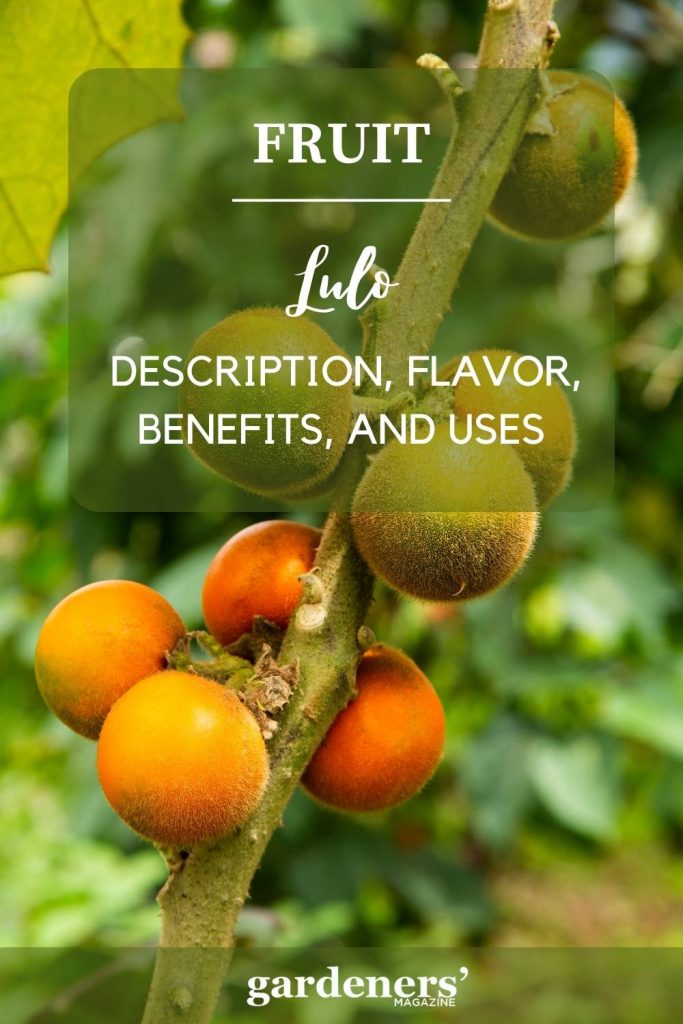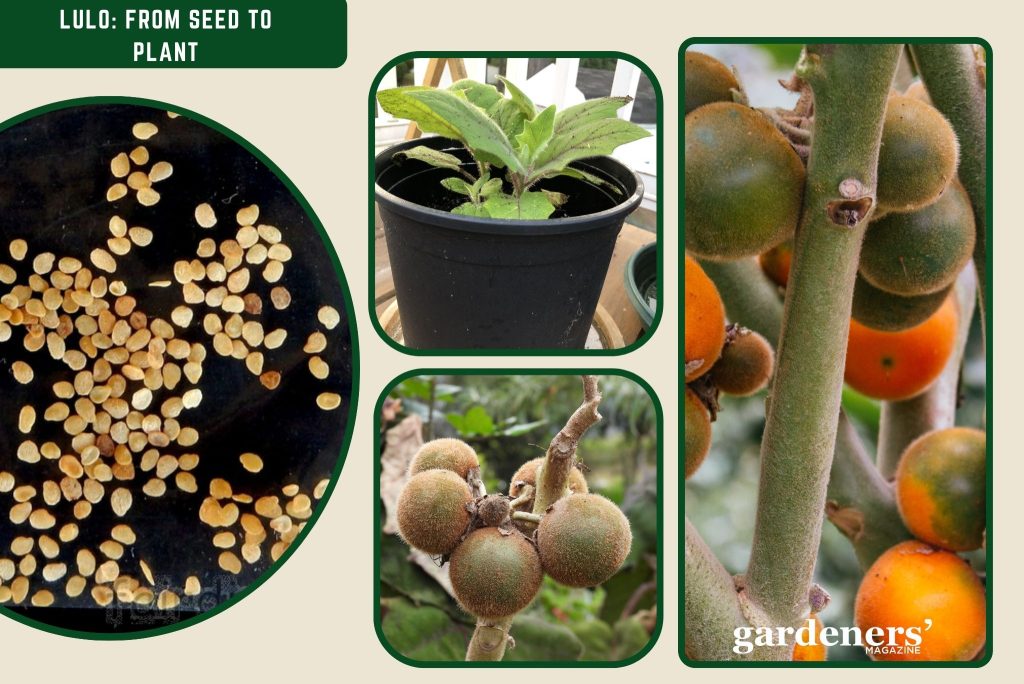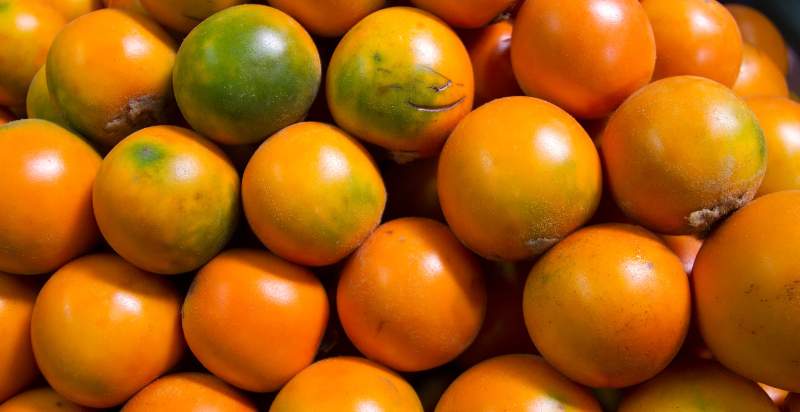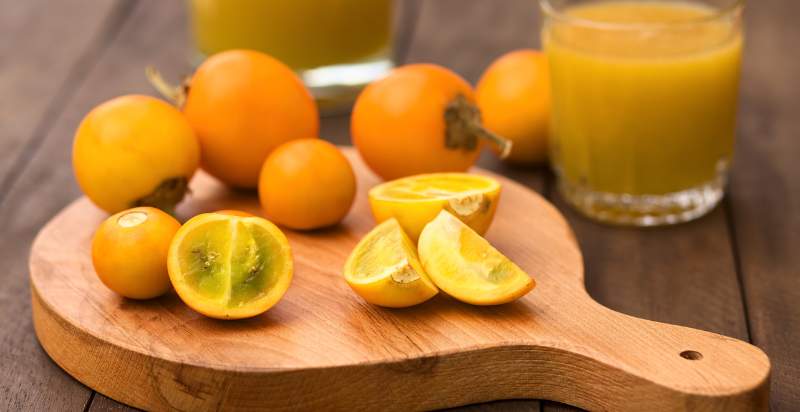Let me tell you about a little treasure I’ve discovered in the world of fruits – it’s called Lulo (Solanum quitoense) or naranjilla if you want to get fancy. This tropical fruit is something special, not just another fruit. It’s got this vibrant green exterior and inside, a surprise of tangy, citrusy goodness that can brighten up any dish. But Lulo isn’t just about the taste; it’s a fruit with deep roots in various cultures, especially in South America where it’s a staple in many traditional recipes.
People there have been enjoying Lulo’s unique flavor and health benefits for ages, and now, it’s starting to make waves elsewhere too. Growing Lulo has been an adventure for me, learning about its likes and dislikes, and I’m here to share that journey with you. So, if you’re curious about adding a splash of tropical flavor to your garden and kitchen, stick around as we dive into the world of Lulo!
What is Lulo?
Lulo is a tropical fruit native to South America, particularly Colombia and Ecuador (tropical fruit). It has a sweet and sour taste, similar to an orange or lemon. The fleshy center of the lulo contains several small edible seeds. Its skin is typically yellow-orange and covered with small hairs. Lulo is often used in desserts and smoothies or as a garnish on salads. It can also be juiced, blended into sauces, or cooked with meats and vegetables. Try adding lulo to your next recipe for a nutritious and tasty boost.

History and Origin
The lulo’s scientific name is Solanum quitoense, and it belongs to the same family as tomatoes, potatoes, eggplants, and chili peppers. It grows in tropical climates on a vine that can reach up to five meters long. The leaves are large and ovate, while the fruit is round and yellow with a thin skin that is easily broken or cut. It has few seeds compared to other fruits, making it easier to prepare and enjoy.
The lulo is believed to have originated in the Andes mountains as early as 2000 BC when the Inca civilization first cultivated it. It became a popular part of their diet and eventually spread throughout South America. In Colombia, lulo is widely used in traditional dishes such as salads, juices, stews, and desserts. Its tart flavor makes it a great accompaniment to fish or poultry.
The versatility of lulo makes it a great ingredient for both savory and sweet dishes. It can be used in jams, jellies, juices, ice creams, soups, and cakes. Its tart flavor is often combined with other flavors, such as ginger or honey, to create unique flavor combinations. Lulo can also be frozen and stored for later use.
Description
The lulo is a round fruit ranging from 2-4 cm (0.8-1.6 inches) across. Its thin, yellow skin is easily broken or cut and has few seeds compared to other fruits. The pulp inside is a vibrant orange color with a tart flavor similar to a lemon or lime. For its unique flavor, the lulo is often used in juices, jams, jellies, and other dishes. It is also a nutritious fruit, providing an excellent source of Vitamin C and other essential vitamins and minerals.
Flavor Profile
Picture this: a fruit that’s a little bit of everything good. The flavor profile of the lulo is unique and can range from sweet to tangy and sour. It has a slight tartness that provides a refreshing balance. The taste also has subtle notes of tropical fruits such as pineapple, mango, and passionfruit. Interestingly, the flavor profile of lulo can change depending on how ripe it is when eaten—the riper it is, the sweeter the taste will be. For anyone who loves a bit of adventure in their food, Lulo is a must-try. It’s that unique taste you’ve been looking for, trust me.
Lulo is often used in juices, smoothies, jams, jellies, desserts, and even cocktails. It’s also a key ingredient in many popular Colombian dishes like the traditional soup Ajiaco Santafereño or the delicious Bandeja Paisa. Whatever way you choose to enjoy it, lulo is sure to add an explosion of flavor and refreshment to your palate. So, why not give this delicious fruit a try? You won’t regret it.
Health and Nutritional Benefits
This little fruit is not just a treat for your taste buds but also a powerhouse of goodness for your body. Imagine a fruit so packed with vitamins and antioxidants that it’s like a natural health booster.
Growing Lulo in my garden has been more than just a gardening adventure; it’s been a journey into discovering how a single fruit can be so beneficial. Lulo is loaded with Vitamin C, which is great for your immune system. It also has antioxidants that help fight off those pesky free radicals. Plus, it’s a good source of vitamins A and B, which are fantastic for your eyes and skin.
But what’s really amazing is how all these benefits come in such a tasty package. Adding Lulo to your diet is like giving your body a high-five. It’s nature’s way of saying, “Here, have some deliciousness and some health, all in one go.”
Cultivation
The lulo plant is an easy-to-grow, resilient crop that will thrive in almost any climate. Let me share some tips that have helped me along the way, hoping they’ll do the same for you. This tropical fruit needs a bit of special care, but trust me, it’s well worth the effort.
Planting:
You’ll need to get your hands on some Lulo seeds. Once you have them, start by soaking the seeds in water for about 24 hours. This little trick helps to wake them up and get them ready for planting.
Next, fill a pot with a good-quality potting mix. Lulo loves well-draining soil rich in organic matter. Think of it like making a comfy bed for your plants, where they can easily stretch out without getting their feet wet. A mix of garden soil, compost, and a bit of sand does the trick nicely. Lulo seeds love soil that drains well. Plant the seeds about a quarter-inch deep and cover them lightly with soil. The ideal depth for planting lulo is between 2 and 4 cm. Plant the seeds in rows about 20-30 cm apart, with a 5-10 cm spacing between each plant. After sowing, keep the soil moist, but be careful not to overwater. Lulo seeds like to stay damp but not soggy.
Place your pot in a warm spot with plenty of indirect light. Patience is key here, as Lulo seeds can take a few weeks to sprout. Once they do, make sure they get plenty of light – a sunny windowsill is perfect. It can be grown in containers or planted directly into the soil.

Care:
As your Lulo plants grow, keep the soil consistently moist and give them a balanced liquid fertilizer every few weeks. They’ll also appreciate a bit of extra humidity, so a light misting now and then will make them happy.
When the plants are big and strong enough, and there’s no more risk of frost, you can transplant them outside if you like. Just remember, Lulo plants love the sun but they do need some protection from the hottest rays. Lulo plants enjoy a spot that gets plenty of morning sunlight but is shielded from the harsh afternoon rays. If you’re in a cooler climate, a greenhouse or a sunny window can be your Lulo plant’s best friend, offering warmth and light.
The plants should start to appear within two weeks and can be harvested when they reach maturity, which usually occurs around three months from planting. Lulo is best harvested early in the morning when the fruit is firm. The fruits can then be consumed fresh or used for making preserves, juice, and other products. With proper care and attention, the lulo plant can provide a reliable harvest year after year.
Zone-specific Advice:
Now, about those climate zones – Lulo is a bit of a diva and prefers the warmth. In zones 9-11, you can grow Lulo outdoors year-round. For those in cooler zones, don’t fret! You can start seeds indoors and transplant them outside after the last frost, or grow them in pots and bring them inside when the temperature drops. Remember, Lulo doesn’t like the cold, so keep them warm and cozy.
Harvesting
Depending on the variety, Lulo fruits can be harvested from June to November. Fruits should be harvested when they are well-matured and have a yellow or orange color. Harvesting of lulos is usually done by hand, but mechanical harvesters can also be used. Yields range from 20-50 kilograms per plant in one harvesting season. The harvested fruits are then sorted and packed in boxes for transport. The fruits must be handled with care to avoid spoilage.

Where do Lulo Grow region-wise?
Lulo is mainly grown in the tropical regions of South America, including Colombia, Ecuador, Peru, Bolivia, and Brazil. It is also grown in some parts of Central America and the Caribbean. Lulo has been produced commercially for centuries in many different areas worldwide. In addition to its traditional use as a fruit in local dishes, lulo has recently gained popularity as an ingredient in health and beauty products, juices, syrups, jams, and jellies.
In many countries, it is also gaining popularity as a gelling agent and flavor enhancer for food products. Lulo has become especially popular in Colombia, where it is used to make delicious desserts such as lulada (a type of ice cream) and jugo de lulo (lulos juice).
Availability: Lulo in the USA and Beyond
As a knack for trying out exotic plants, I’ve been following the journey of Lulo with great interest. It’s not your run-of-the-mill fruit in the USA, but its unique, tangy flavor is starting to catch on. I’ve seen it pop up in specialty food markets and online, and it’s thrilling to see more people get curious about it.
In my own kitchen, I’ve been experimenting with Lulo, adding its zesty taste to smoothies and even some bold savory dishes. But Lulo’s story isn’t just happening here in the States. Back in its homeland, in places like Colombia and Ecuador, Lulo is much more than a fruit; it’s part of the culture. There, it’s used in everything from traditional drinks to sweets. It’s fascinating to see how a fruit so integral to South American cuisine is starting to sprout roots in the USA and beyond.
Where to Find Lulo: Shopping Guide
Finding Lulo can be a bit like going on a treasure hunt, but don’t worry, I’ve got some tips to help you out. If you’re after the fruit, seeds, or plants, your best bet is to start with specialty grocery stores or garden centers, especially those that focus on exotic or tropical plants. These places often have a good selection, and you can chat with the staff for extra advice.
Online shopping is another great option. There are plenty of websites that sell Lulo seeds and plants. Make sure to read reviews and check the seller’s reputation to ensure you’re getting quality products.
So, whether you’re browsing your local exotic market or scrolling through online gardening sites, keep these tips in mind.
What must you Remember when Buying Lulo?
When buying lulo, it is important to keep in mind the following:
- Buy lulo that is fresh, firm, and unblemished. Avoid any fruits with soft spots or mold.
- Consider the size of the lulo when selecting your purchase; smaller ones are sweeter.
- Choose lulos that are fragrant and heavy for their size.
- Consider buying organic lulo to reduce your exposure to potentially harmful chemicals and pesticides.
- If you’re planning on freezing or preserving the lulo, it’s best to buy slightly underripe ones so they won’t become too soft during processing.
- Store lulo at room temperature away from direct sunlight; they are best enjoyed within a week of purchase.
- Rinse and dry the lulo before eating or using it in recipes to remove dirt or debris. Enjoy!
What is the Best Way to Store?
The best way to store lulo is to wash them thoroughly, remove the stems, and place them in a plastic bag. Remove as much air from the bag as possible before sealing it. Store the sealed bag in a cool, dry place such as a refrigerator or pantry. Lulo can be stored for up to two weeks when properly stored. Please keep them in the refrigerator for the longest shelf life, where they will last up to four weeks.
You can also freeze lulo for long-term storage. To do this:
- Blanch the fruit by boiling it for a few minutes and then plunge it into an ice bath to stop cooking.
- Dry off any excess moisture and place the lulo in a plastic bag.
- Squeeze out as much air as possible before sealing the bag and storing it in the freezer.
- Frozen lulo can last up to one year when stored properly.
When ready to use, thaw lulo in the refrigerator overnight or submerge them in a bowl of cold water for about an hour until they are soft and pliable.
Culinary Uses: From Juice to Pulp
Lulo is a versatile fruit that shines in both cooking and beverages. Its unique tangy flavor makes it perfect for a variety of dishes. You can use Lulo to create refreshing juices that are a hit on any warm day. It’s also great for making smoothies, adding a vibrant taste that’s both delicious and energizing.
In cooking, Lulo can be used to make salsas that pair wonderfully with chips or as a topping for tacos, giving a fresh, citrusy twist to your meals. Additionally, incorporating Lulo into sauces can elevate the flavor of fish or chicken dishes, offering a taste of the tropics right on your plate.
When combined into a salad, lulo’s tart flavor complements sweet ingredients like strawberries or dates nicely. When using lulo in smoothies, it can be blended with yogurt or milk to create a thick and creamy texture.
Lulo also goes well with vegetables such as cucumbers, bell peppers, and cabbage. When preparing dishes with lulo, it’s important to remember that its acidic flavor can be too strong when consumed on its own. To balance out the flavor of lulo, consider adding honey or sugar before serving. With creativity and experimentation, lulo can be used to create delicious meals that are sure to please any palate.
For those who enjoy experimenting in the kitchen, Lulo offers endless possibilities to explore new culinary ideas.

The Cultural Significance: A Colombian Citrus Gem
Lulo holds a special place in Colombian culture, where it’s not just seen as a fruit but as a part of the country’s rich heritage. This citrus gem is a staple in many Colombian homes, celebrated for its unique flavor that adds a zesty twist to traditional dishes. It’s like the secret ingredient that brings a burst of freshness to every meal.
In Colombia, Lulo is more than just something to eat; it’s a symbol of home and family gatherings. One of the most popular ways to enjoy Lulo is in a refreshing drink called Lulada, especially on hot days. It’s like a taste of Colombian sunshine in a glass. But its use goes beyond just beverages; Lulo is also a key ingredient in sauces and desserts, showing its versatility and how deeply ingrained it is in the culinary traditions.
The love for Lulo extends to celebrations and festivals, where it’s shared with friends and family, strengthening bonds and creating memories. Its presence in Colombian cuisine is a testament to the country’s love for flavors that are bold and vibrant, much like its people and landscapes. Lulo, with its tangy taste and cultural significance, truly is a Colombian citrus gem that captures the essence of the country’s rich and colorful culture.
Conclusion
Lulo is an interesting and unique fruit native to South America that offers a tart, citrusy flavor. It can be enjoyed fresh or frozen for long-term storage and used in various dishes, including salads, smoothies, and more. With its acidic flavor, lulo can be balanced out with other sweet ingredients or a touch of honey to enhance its flavor. Whether you’re looking for something new to add to your recipes or want to try something different, give lulo a try! It may quickly become one of your favorite flavors.
Frequently Asked Questions:
What does a Lulo fruit taste like?
Lulo has a unique taste that’s a mix of tart and sweet, kind of like a lime crossed with a rhubarb and a hint of pineapple. It’s really refreshing!
Is Lulo fruit good for you?
Yes, Lulo is great for your health! It’s packed with vitamins A and C, antioxidants, and minerals. These nutrients help boost your immune system and keep your skin healthy.
Is Lulo a persimmon?
No, Lulo isn’t a persimmon. They’re totally different fruits. Lulo is also known as Naranjilla in some places and belongs to the nightshade family, while persimmons are a type of berry.
How do you eat Lulo fruit?
You can eat Lulo in a few ways. Most people like to cut it in half and scoop out the inside to eat fresh or use it in juices and smoothies. You can also cook it into jams or desserts.
Where to buy Lulo fruit in the USA?
Finding Lulo in the USA can be a bit tricky, but your best bet is to check out specialty grocery stores or Latin American markets. You can also look online for places that sell exotic fruits.
- Lulo: Description, Flavor, Benefits, And Uses - March 19, 2024
- Banana Leaves: Benefits, Uses, Growing Tips & Cultural Information - March 11, 2024
- How to Grow Strawberries Successfully in Containers - March 8, 2024

1 thought on “Lulo: Description, Flavor, Benefits, And Uses”
Comments are closed.